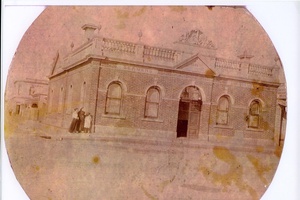This item is a part of these Tours
Beach to Borough: Liardets Beach and early Sandridge
Jump To TourThis record is a stop on a tour which goes to other places. Pick up the tour by jumping to it from here. Check the map to see where it goes. You can jump back to this place later.
This item is in these Collections
Morley's Coal Depot
Jump To CollectionThere are other records in this place that are not on the tour. Explore this place by jumping to it from here. You can jump back to this tour later.
Other content from this author
-
Bay Street
The founding of Sandridge (which later changed its name to Port Melbourne) began one November day at the place where Bay Street now meets the beach, with the arrival on this shore of one of history’s most unusual families, the Liardets. It was 1839. Melbourne’s booming settlement two miles to the north beyond the Yarra River was four years old. Hobsons Bay was already busy with ships, but although this ‘dazzling white’ beach was popular as a landing place for arrivals planning to walk overland to Melbourne, no one had actually settled here. (Two fisherman of dubious character, camped in a hogshead on the beach when the Liardets landed, have never been classed as settlers.) Pitching tents fashioned in London for use in the colonies, adventurer Wilbraham Liardet, his wife Caroline and their nine children set about creating a home on the Beach, and serving their fellow pioneers. Within a year they had: constructed a jetty, a watchtower and a rough road to Melbourne; dug a well; established a ferry service between the Beach and William’s Town and a daily mail run between the town and the ships; and built their bayside resort, the timber Pier Hotel, a forerunner of the one that took its place on the site in 1856.
PMHPS
-
Port Melbourne Yacht Club
Liardet’s ti-tree jetty was replaced ten years later by the Town Pier, around which Sandridge grew. Over a century after the 1854 opening of a railway shifted maritime activity toward the west (where you can now see Station Pier), the Town Pier was demolished. Port Melbourne Yacht Club is built upon its remnant.
PMHPS
-
Morleys Coal Depot
The depot stored coal from Newcastle that arrived at Town Pier to fuel the ships. Though not built until 1872, this handsome, classified bluestone building is a reminder of the many warehouses that sprang up around this beach, together with the ships’ chandlers, manufactories and ubiquitous pubs to be found in a port town. Along both Beach and Bay Streets the village of Sandridge grew slowly, bounded on the east by a lagoon and on the west by the sandhills that gave it its name. Then with the 1851 discovery of gold in Victoria, the handful of settlers at the Beach abruptly swelled to nearly 3,000. In 1860 the village gained independence and proudly proclaimed itself the Borough of Sandridge. It took the name of Port Melbourne in 1884 and became a City in 1919, but is still referred to by long-time residents as ‘the Borough’. Port’s VFL footy team carries on the name.
PMHPS
-
Liardet Memorial
The city’s 1988 Bicentenary contribution utilizing bluestone from demolished Harper factories.
PMHPS
-
Public Toilets
The two public toilets date from around the WW1 period. The multi-lingual signs, in English, Italian and Greek, were added in the 1950s and indicate the make-up of the early post-WW2 immigrant streams who entered Australia through Port Melbourne.
PMHPS
-
Masckell McNab Memorial
The Maskell McNab Memorial that once stood near Graham railway station, is a tribute to two local railway men who died in the horrific 1887 smash at Windsor on the Sandringham line. It was shifted here after the rockery at Graham and Station Streets was replaced by an overpass in 1970. Note the lone art deco pylon beyond. This is the sole remnant of the State’s grand monument to one hundred years of European settlement—the impressive 1934 Centenary Bridge. Built by ‘susso’ labour in the great depression, it was demolished with difficulty in 1991. The former Port Melbourne Railway Station can be seen ahead. Plans to connect Melbourne by rail to ships in the bay were realized in 1854 when the Hobsons Bay Railway opened, the first in Australia. The rail route is now utilised by the 109 tram.
PMHPS
-
The Anchorage
Across Beach Street is another eminent factory landmark, which in the 1990s became ‘The Anchorage’. Its unique residential spaces occupy remnants of the Swallow & Ariell biscuit factory. This complex comprised a variety of bakeries constructed over a one hundred year period from 1858, as you will observe in the evocative architecture and decorative detail if you walk around those structures which remain. Established in 1854 to bake ships’ biscuits, ‘Swallows’ was a major local employer. Virtually every Port Melbourne family had at least one person working there. Later Arnott’s biscuits, it closed in 1991 with a mourned loss of bakery smells to the neighbourhood, older portions were listed on the Historic Buildings Register, but its development as a residential area involved the demolition of some of the 20th century buildings. Fortunately those of the 19th century survived. On the corner of Rouse and Stokes Street is the earliest of the remaining buildings, which dates to 1858. In those days Thomas Swallow’s family home was on the top storey, and the employees took meals there with them.
PMHPS
-
St Josephs Hall and Church
On opposite corners are St. Joseph’s hall and church (unusual in that in 1857 this Romanesque style was rarely used for Roman Catholic churches), and the former Swallow & Ariell offices, missing its original tower.
PMHPS
-
Freemasons Tavern
The Freemasons tavern, later the Sandridge Hotel and now redeveloped, stood next to the original Freemasons Hall of the 1858 Sandridge Lodge. See the plaque on the Beach St face. A new temple was built in Liardet Street in 1919.
PMHPS
-
Tram Depot
Around the corner at Donaldson and Beach Streets was one of the eleven depots of Melbourne’s world renowned cable tram system. Containing Melbourne’s only remnant cable track, it was demolished in 1999 and replaced, like other bayfront heritage buildings by residential development. Port Melbourne’s cable tram from the city operated from 1890 until 1937, running up Bay Street and along Beach Street to the station, on what is now the median plantation.
PMHPS
-
The original Seamens Institute building
The original Seamen’s Institute building is at Nott and Beach Streets. It replaced a small, timber bethel in 1888 and served until 1937, when the local Missions to Seamen moved to a notable Modernist building between Princes and Station Piers. The cornerstones you noted earlier have come from both of these buildings.
PMHPS
-
Post Office and Mail Exchange
Walking down Bay Street, near the corner of Rouse St, you will note the 1912 Naval Drill Hall next to the original Sandridge Post Office and Mail Exchange designed by colonial architect J.J. Clark. Built in 1860, it was one of the busiest mail exchanges in the colony. After the town centre and Post Office had shifted northward, the Navy occupied both buildings until 1992. On the opposite corners are the original Exchange Hotel, and, across Rouse St the site of the former St. Joseph’s primary school 1906-1963.
PMHPS
-
Former National Bank
Like most buildings along Bay Street, many of those toward Graham Street date to the latter half of the 19th century. Notable is the classified former National Bank, designed 1874 in Italian Renaissance style by architect Leonard Terry, and extended in 1889. Across the lane from the old bank building, a real estate office occupies an 1866 grocery shop, which has survived despite the new residential which looms beside and above it. Down the lane called Little Dow Street, catch a glimpse of the tiny 1866 Army and Navy Hotel —closed long ago and now restored as offices.
PMHPS
-
The colonial law and order complex
The colonial law and order complex at Graham Street now serves other purposes, the police station being legal offices and the 1860 court house, also by J.J. Clark, being a bar and restaurant. Note the small but grim two-cell bluestone lockup behind it. Around the corner, a new apartment block occupies the site of the original Borough Council Chambers. Historic Holy Trinity Anglican was on the opposite corner. It began in a tent in 1854 to become the leading Sandridge church, but now facaded and surrounded by unsympathetic structures. Our hope for the new century is that ‘the Borough’ will suffer no further loss of its remaining colonial heritage.
PMHPS

